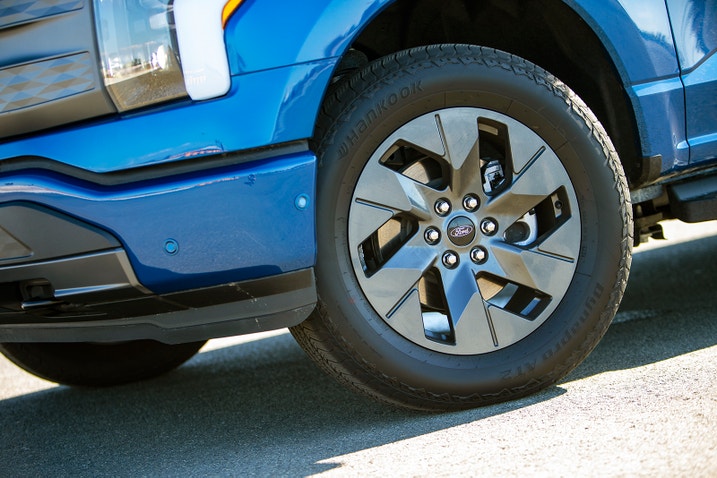- We purchased an electric Ford F-150 Lightning and a gas-powered Ford F-150 Hybrid.
- We've been testing and living with them both for more than a year.
- Our writer makes a case for why Lightning doesn't live up to the hype.
I'm Not Sold on Our Long-Term Ford F-150 Lightning
After extended time behind the wheel of an F-150 Hybrid and an F-150 Lightning, I'm not sure why you'd buy the EV
We bought a Ford F-150 Lightning with our own money more than a year ago. It's part of Edmunds' long-term test fleet that allows us to share our experiences of what it's like to drive and own a vehicle for a year or more. Notably, we also own a regular 2021 F-150 fitted with the hybrid powertrain. Of the two trucks, there's one that I think is clearly the better buy. And it's not the F-150 Lightning.
Now, I want to first point out that the F-150 Lightning is our Top Rated Electric Truck for 2024. For our award, we wrote the Lightning won "... because it was designed to be a truck first and an electric vehicle second. It combines extra versatility with effortless performance." I'm not contradicting that. But after spending a good chunk of time with both F-150s I've come to realize that it's the regular F-150 that I much prefer driving. There are two big reasons why.
The Lightning's ponderous handling wears on you
Yes, they are both F-150s and have near identical dimensions. But the Lightning drives significantly larger than other big trucks I've piloted. It's likely the Lightning's weight and suspension tuning that make it feel so cumbersome. As my co-worker Brent Romans wrote in our logbook: "[Our Lightning] feels portly and wobbly when driving over bigger bumps or undulating pavement. Go over a series of bumps and the truck bobs and floats around more than a big guy getting onto a 1980s waterbed." It's similarly not up to the task when driving around corners.
As such, I'm always aware of its 6,745 pounds. Compared to our hybrid F-150, which is noticeably more buttoned-down and nimble, the Lightning requires an extra amount of mental concentration to make sure I'm driving it safely. Even our long-term Rivian R1T, which is even heavier than the Lightning, is less arduous to drive. Credit goes to its smaller size and specialized suspension that keeps the truck's mass more in check.
Am I Ready for an EV?
- EV ownership works best if you can charge at home (240V outlet) This typically means a 240V home installation, or other places your car is parked for several hours each day. Don't expect a regular household outlet (120V) to suffice.
- Adding a home charging system is estimated to cost $1,616 in This is an estimate for your area. Using your address and the answers you provide, Treehouse can provide a more accurate price.
- Edmunds is partnering with Treehouse, an independent provider of home EV installation services. Learn more Edmunds customers receive a 10% installation discount and 4% smart charger discount. Discount excludes permit, hosted inspection, and load management devices. Valid for 30 days.
The charging experience is not the best
I'm fortunate in that I can charge the Lightning at the apartment complex where I live. There are numerous Level 2 chargers in my parking garage and I've never rolled snake eyes when trying to secure one. It's certainly more expensive than if I lived in a home with a garage and a charger of my own, but the median sale price of a home in Orange County is north of a million dollars. So, you get what you get.
But the cost to charge is high. And that's not just because I'm being gouged for electricity (although, probably). The Ford F-150 Lightning is one of the least efficient electric vehicles Edmunds has tested, though it edged out the Rivian R1T. In the 15,000 miles we've driven so far, the Lightning has fallen short of Edmunds' official EV Range Test efficiency (not a surprise given the type of driving we typically subject our long-term vehicles to) and is using approximately 51 kWh every 100 miles. The Lightning has 131 kWh of usable capacity, which leaves our vehicle with an average range of just over 250 miles.
And that's assuming you're fully charged to start and drive the truck to nearly empty. That's a rare situation. In contrast, our team, on average, comfortably drives our hybrid F-150 more than 400 miles between gas fill-ups. Its maximum tested range, at more than 700 miles, also greatly exceeds the Lightning's of 332 miles.
Edmunds has reported on the diminished range of electric vehicles when subjected to arduous towing. And while we were impressed that the Lightning's efficiency dropped by only 26% in our test, that doesn't change that you'll almost certainly need to stop, unhook your trailer and charge the Lightning if you take it even a modest distance while towing. Finding a public charger should become easier for Ford owners now that they can access Tesla's Supercharger network. But you know who has the easiest experience? Truck owners who don't need to plug in their vehicle at all.
Dubious savings on fuel
It costs me 37 cents per kWh to charge the Lightning using the Level 2 charger in my building, which added up to 24 cents per mile. We can make that number a little easier to deal with by thinking about the per-100-mile cost, in this case, $24. So, what would this have looked like had I been behind the wheel of the hybrid Ford F-150?
We've been disappointed by our real-world fuel economy in the hybrid and have seldom touched the EPA-estimated 24 mpg in combined driving. But even at our 20-mpg observed average, let's run the numbers. One hundred miles would require 5 gallons of gasoline. The current average gas price in Orange County is $5.36, which brings the cost to $26.38 — that's $2.38 more per 100 miles than using the electric truck.
That's a savings of $238 in the Lightning every year if you drive 10,000 miles annually. I'm not going to tell you that $238 is insignificant, but by electricity savings alone it would take decades to make up for the Lightning's higher price.
Individual use cases will, of course, vary wildly. If you're charging your Lightning in Idaho (where electricity and gas are quite cheap), you're almost certainly saving more money. But on the flip side there's a much smaller public charging infrastructure in Idaho than California.
The decision tree
So, what's the point of the Ford F-150 Lightning? If you like the F-150 (and who doesn't!) and want something different, powerful and futuristic, I suppose the Lightning is for you. And certainly, future Lightning iterations may continue to improve the product for consumers. But if I'm buying a truck in 2024, and I actually want to use it for, you know, truck stuff, I'm going to stick with the perfectly cromulent hybrid F-150 we already have.








 by
by  edited by
edited by